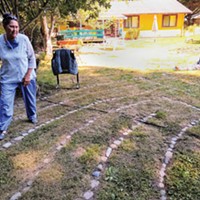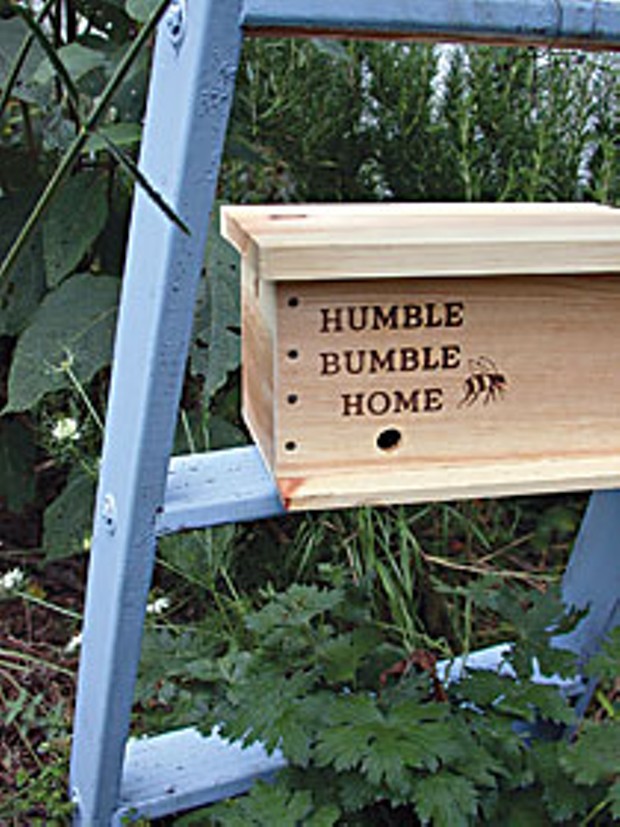[
{
"name": "Top Stories Video Pair",
"insertPoint": "7",
"component": "17087298",
"parentWrapperClass": "fdn-ads-inline-content-block",
"requiredCountToDisplay": "1"
}
]
I'll do just about anything to make a bee happy. I've filled my garden with asters and sedum and whatever else the bees seem interested in. I let leaf cutter bees carve tiny holes in my rosebushes and fly off unsteadily with a bit of green clutched between their legs. (I think they use the leaves to line their nests, which are really just tiny little spaces in bits of rotten wood where their larva hatch.) I heard that some species of native bees dwell underground in winter and that over-mulching can ruin their habitat, so I'm even rethinking my mulch strategy just for them. And of course, I never, ever use pesticides in the garden.
All this effort seems to have paid off. My apple trees were clearly well-pollinated this spring; the branches are bent over with the weight of the fruit. On a warm day, the garden is simply overrun with bees, butterflies and other creatures scouting for pollen and nectar. It's like the Discovery Channel out there, only without the commercials.
But that's not enough. I continue to get suckered into buying toys for my bees. Last spring I bought a bee block, a wooden block drilled with holes where solitary native bees could nest. I even bought bee larva in tubes. They were supposed to hatch and fly around in spring, but to my horror, only one or two made it out and the rest died in their little cardboard chamber. It was a disheartening experience, but I carry on.
Now I have purchased a new toy for my bees: the Humble Bumble Home. It's a plywood box that resembles a birdhouse, with a couple holes for access and air, and a layer of cotton bedding inside. Apparently some species of native bumblebees build small colonies in the spring to hatch their young. Unlike the European honeybees, these are not large, permanent hives, but small, temporary constructions of wax cells holding six to eight eggs. (Apparently the queen sits on the eggs like a chicken, which is a charming idea, but I wonder how much heat a bumblebee really gives off.)
These colonies can be found, according to the instructions that came with my bee house, in abandoned corners of the garden or under the eaves of a shed. This house is supposed to meet the needs of the bees throughout the summer season, at which time they'll abandon their shelter and go into hibernation for the winter.
Well, that all sounds pretty cool. So I just set the house outside and wait for some bees to show up, right?
Not so much. According to the instructions, I have three options for inviting bumblebees into their new home:
Method 1 : Find a quiet spot on the north side of the house or behind some shrubs. If it might rain in your climate, place an old cookie sheet or a piece of roofing paper on top and use a brick to weigh it down. If there are raccoons are skunks, elevate the house to keep the bees out of harm's way. It's remotely possible that bees will show up, but the instructions warn that "like birdhouses, Mother Nature doesn't guarantee occupancy."
As attractive as an elevated, cookie sheet and brick-covered bee house sounds, I think I'll pass. Anyone who has ever met a raccoon or skunk knows that simply elevating a food source off the ground won't deter them. Besides, don't bumblebees have to deal with rain and predators anyway? I don't coddle my plants; I'm not going to coddle the bugs. On to the next option.
Method 2 : Capture the queen. Sit out in the garden in spring and look for a bumblebee that doesn't have pollen on its legs. That's likely to be a queen looking for a colony. Sweep her up into a jar, and put her in the fridge for a few minutes to slow down her metabolism so that she'll be sluggish when you put her in prison. Then dump her into the bee house, give her a little dish of half honey and half water to eat, plug up the hole and leave her there for 36 hours. Hopefully she'll like her new house so much that she'll decide to stay and make babies.
Okay, I can't even find my car keys. There's no way I'm going to find a queen bee in the garden. Next?
Method 3 : This, the instructions promise, is the exciting way. Don one of those fabulous mesh hats that beekeepers wear and go looking for an active colony. Follow a few bees home or dig around in your compost pile or some other undisturbed area in hopes of exposing the comb. Act quickly to stuff it into your bee house. "Now you are in control," the instructions say reassuringly.
But you can't move the colony to its new home yet. Leave it sitting right where it is, unplug the entrance hole and let the worker bees buzz around and find out where their queen has gone. Wait until late at night, when they're all asleep, and then plug up the entrance hole and put the bee colony in its new location.
If you can't wait until nightfall, there's another procedure that involves capturing individual bees, placing them in empty 35mm film canisters, and putting the bees on ice so that they fall into a "cold induced torpor." You are warned to chill them but not freeze them. The chilled bees can then be tossed into their house, and by the time they wake up, they won't care where it's located.
Film canisters? Ice cubes? And besides, if the bees already have a place to live, why am I relocating them at all?
I know why. This is not really a toy for the bees. It's a toy for me. Now that I realize that, I'm taking it outside and putting it in whatever location appeals to me. It's a charming little ornament for the garden, and I hope it gets used for its intended purpose, but really, the bees are going to have to figure this one out on their own. I can't do everything for them. All this time spent tending to the needs of bees makes me wonder if it wouldn't just be easier to go outside and pollinate the flowers myself.
Speaking of Garden
-

Centro del Pueblo Sanctuary Garden Vandalized Again
Jan 3, 2023 -

Centro Del Pueblo Sanctuary Garden Sign Vandalized, Vigil Planned
Jul 21, 2022 -

Labyrinth Labor of Love
Sep 3, 2020 - More »
Comments
Showing 1-1 of 1
more from the author
-
NCJ Archive: Bring on the Bugs
- Oct 28, 2020
-
Cocktail Garden Crazy Talk
- Jun 13, 2013
-
Now You're Pushing It
- May 9, 2013
- More »
































